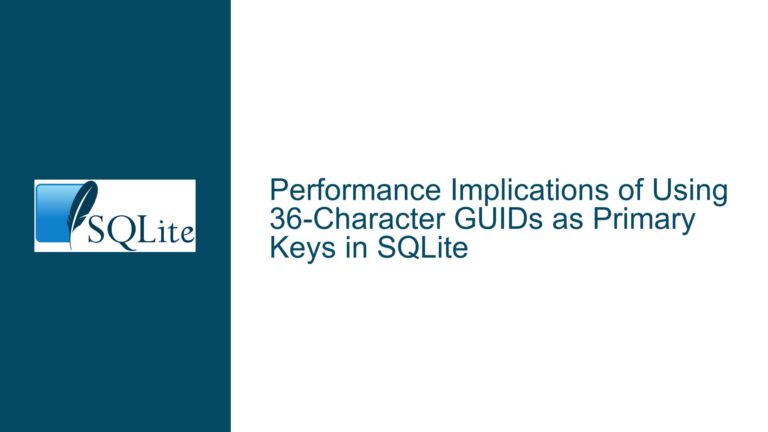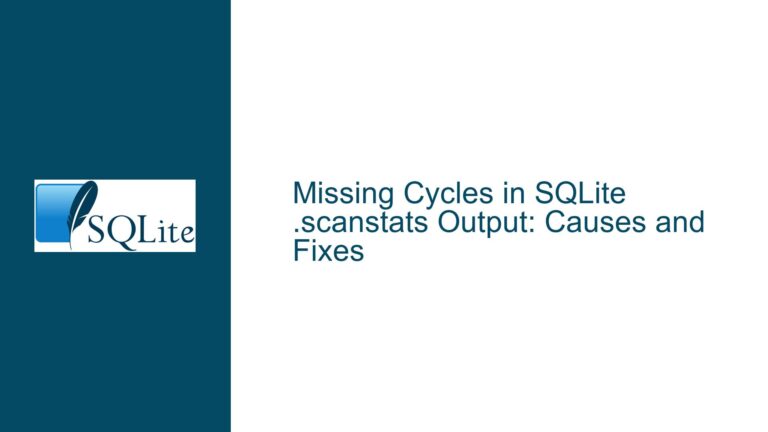Dropping Indexes Before Inserting: Efficiency Trade-offs and Best Practices
Understanding Index Maintenance During Bulk Inserts
When working with SQLite, one of the most common performance considerations revolves around how indexes are maintained during bulk insert operations. Indexes are critical for speeding up query performance, but they come with a cost: every insert, update, or delete operation must also update the associated indexes. This can lead to significant overhead, especially when dealing with large datasets or frequent insertions.
The core issue here is whether dropping indexes before performing bulk inserts and recreating them afterward is a viable strategy for improving performance. The assumption is that by temporarily removing indexes, the insert operations will complete faster, and the subsequent index creation will be more efficient than maintaining the indexes during the inserts. However, this approach is not without its trade-offs, and understanding the nuances is crucial for making informed decisions.
The Impact of Index Updates on Insert Performance
Indexes in SQLite are implemented as B-trees, which are self-balancing tree data structures that maintain sorted data and allow for efficient search, insert, and delete operations. When a new row is inserted into a table, SQLite must also insert corresponding entries into all associated indexes. This means that for every row inserted, the B-tree for each index must be traversed to find the correct position for the new entry, and the tree may need to be rebalanced if the insertion causes a page split.
The cost of maintaining indexes during inserts can be significant, especially if the indexes are large or if there are multiple indexes on the table. Each insert operation not only writes the new row to the table but also updates each index, which can lead to a large number of disk I/O operations. This is particularly true if the database cache is not large enough to hold all the modified pages, forcing SQLite to write changes to disk more frequently.
Evaluating the Drop-and-Recreate Index Strategy
The idea of dropping indexes before bulk inserts and recreating them afterward is based on the premise that the cost of rebuilding the indexes from scratch after the inserts are complete is less than the cost of maintaining the indexes during the inserts. This can be true in some cases, particularly when the number of rows being inserted is very large. However, there are several factors to consider:
Index Rebuild Time: Rebuilding an index from scratch can be a time-consuming operation, especially for large tables. The time required to rebuild the index must be weighed against the time saved by not maintaining the index during the inserts.
Transaction Overhead: If the inserts are performed within transactions, the overhead of maintaining the indexes during the inserts may be reduced. SQLite uses a write-ahead log (WAL) mode, which can help mitigate some of the I/O overhead by batching writes to disk.
Cache Size: The size of the database cache plays a significant role in the performance of index maintenance. A larger cache can hold more modified pages in memory, reducing the need for frequent disk I/O. If the cache is too small, the performance of both inserts and index maintenance will suffer.
Data Distribution: The distribution of the data being inserted can also impact the performance of index maintenance. If the new data is sorted or partially sorted, the B-tree may require fewer rebalancing operations, reducing the overhead of maintaining the index.
When to Drop and Recreate Indexes
Given these considerations, dropping and recreating indexes can be a viable strategy in certain scenarios:
Very Large Bulk Inserts: If you are inserting a large number of rows (e.g., millions of rows), the cost of maintaining the indexes during the inserts may outweigh the cost of rebuilding the indexes afterward. In this case, dropping the indexes before the inserts and recreating them afterward can lead to significant performance improvements.
Infrequent Updates: If the bulk inserts are performed infrequently (e.g., once a day or once a week), the impact of dropping and recreating indexes may be acceptable. However, if the inserts are performed frequently, the overhead of rebuilding the indexes may become a bottleneck.
Limited Cache Size: If the database cache is too small to hold the modified pages during the inserts, dropping the indexes can reduce the I/O overhead. However, increasing the cache size may be a more effective solution in this case.
Alternatives to Dropping Indexes
Before resorting to dropping and recreating indexes, consider the following alternatives:
Increase Cache Size: As mentioned earlier, increasing the size of the database cache can significantly improve the performance of index maintenance during inserts. A larger cache allows SQLite to hold more modified pages in memory, reducing the need for frequent disk I/O.
Use Prepared Statements: Using prepared statements for bulk inserts can reduce the overhead of parsing and compiling SQL statements. This can lead to faster insert performance, especially when inserting a large number of rows.
Batch Inserts: Performing inserts in batches (e.g., 1000 rows per transaction) can reduce the overhead of maintaining indexes. By committing transactions periodically, you can reduce the amount of data that needs to be written to disk at once.
Optimize Index Design: Carefully consider the design of your indexes. Avoid creating unnecessary indexes, as each additional index adds overhead to insert operations. Additionally, consider using covering indexes, which can reduce the need for additional index lookups during queries.
Use the WAL Mode: Enabling the write-ahead log (WAL) mode in SQLite can improve the performance of both inserts and index maintenance. WAL mode allows for concurrent reads and writes, and it can reduce the frequency of disk I/O by batching writes.
Running ANALYZE After Index Rebuild
After rebuilding indexes, it is generally a good idea to run the ANALYZE command to update the database statistics. The ANALYZE command collects statistics about the distribution of data in the tables and indexes, which the query planner uses to make informed decisions about how to execute queries.
However, running ANALYZE after every index rebuild may not always be necessary. The need to run ANALYZE depends on how much the data distribution has changed. If the new data is similar in distribution to the existing data, the statistics may not change significantly, and running ANALYZE may have little impact on query performance.
In general, it is recommended to run ANALYZE periodically, rather than after every index rebuild. For example, you might run ANALYZE once a day or once a week, depending on how frequently the data changes.
Conclusion
Dropping indexes before bulk inserts and recreating them afterward can be a useful strategy for improving insert performance in certain scenarios. However, it is not a one-size-fits-all solution, and careful consideration must be given to factors such as the size of the dataset, the frequency of inserts, the size of the database cache, and the design of the indexes.
Before resorting to dropping and recreating indexes, consider alternatives such as increasing the cache size, using prepared statements, batching inserts, optimizing index design, and enabling WAL mode. These strategies can often provide significant performance improvements without the need to drop and recreate indexes.
Finally, remember to run the ANALYZE command periodically to update the database statistics, but avoid running it unnecessarily, as it can add additional overhead to your database operations.
By carefully evaluating the trade-offs and considering the specific requirements of your application, you can make informed decisions about how to optimize the performance of your SQLite database during bulk insert operations.






